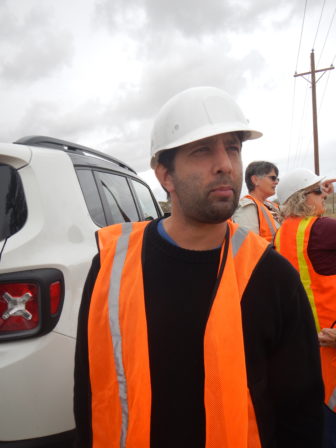Thank you Mr. Chairman, Ranking Member Lowenthal, and Members of the Subcommittee for the opportunity to testify before you in opposition to HR 520, the National Strategic and Critical Minerals Production Act. My name is Aaron Mintzes, and I am with Earthworks. We are a non-profit organization dedicated to protecting communities and the environment from the destructive impacts of mineral and energy development, while seeking sustainable solutions.
Our primary concern is that HR 520 undermines the National Environmental Policy Act (NEPA). Under section 5(b)(1)(F), the lead agency can let any state or federal agency determine:
Whether public participation will occur during the decisionmaking process for authorizing actions under the permit.
So, a state could say “no public participation allowed”. I worry this may result in unintended consequences. If you shut the people out, it may invite litigation or create additional delays the lead agency could avoid if they listen to what the people say. It may not deliver the regulatory certainty permit proponents seek.
NEPA ensures that Americans can take part in the review and development of projects affecting our social, economic, and environmental health. For nearly fifty years, NEPA has provided certainty and predictability through a transparent process well understood by federal regulators, permit applicants, and affected communities.
And it works. In 2016, the GAO reported that BLM and the Forest Service average two years to permit a mine plan of operations. This period is competitive with Australia, Canada, and Chile. Especially controversial projects may take longer than average. Yet, permitting delays primarily result from incomplete information provided by the project proponent. Sometimes for perfectly legitimate reasons like good faith changes in plans of operations or fluctuation in commodity prices.
The United States of America is one of the world’s best places to mine

America owes our mineral investment attractiveness to three factors:
- The strength and certainty of our democratic institutions (like NEPA)
- Our rich mineral endowment
- Our uniquely permissive mining laws and regulations
The 1872 Mining Law
The General Mining Law of 1872 considers mining the highest and best use of public lands, even where our public lands may be better suited for oil and gas drilling, coal mining, grazing, hunting, fishing, recreation, or conservation; because of the 1872 Mining Law, mining wins. This nineteenth-century law robs twenty-first century Americans of the choice to select a different land use that competes with mining.
To secure a mining claim, the miner needs to only discover a locatable mineral on public lands, stake a claim, and pay a one-time $212 fee plus another $155 annually. In exchange, they receive all the people’s wealth below the surface without paying a dime in royalties to the taxpayer. In addition to free minerals, mining companies receive generous tax breaks for depleting our natural resources.
Mining Pollutes Water Forever
The Environmental Protection Agency (EPA) estimates that the clean up cost for our nation’s approximately 500,000 hardrock abandoned mine sites ranges around $50 billion. Unlike with coal mining, the hardrock mining industry pays no federal reclamation fee. So, the clean up burden largely falls upon the American taxpayer.
Mining waste loopholes in the Clean Water Act and RCRA allow mines to dump toxic mine waste directly into streams, rivers, lakes and wetlands. In the midst of declining fresh water supplies, an increasing number of hardrock mines will generate water pollution that will last for hundreds or thousands of years.
Finally, the hardrock mining industry performs especially poorly at predicting whether their projects will create water quality problems. While all mining operations predict their projects will comply with applicable water quality standards, they are often wrong.
Thus, the mining industry gets free minerals, generous tax breaks, and leaves the waste to the rest of us.
Conclusion
The United States needs critical minerals for a variety of important applications including renewable energy and defense technologies. The 140+ year old law that governs mining on public lands gives companies free and open access to these minerals, and, our stable, predictable, fair, and open permitting process provides the certainty the mining industry needs, and the public participation process that communities that live near mines deserve.
The National Environmental Policy Act codifies that certainty. Dismantling this well-established process and removing meaningful public participation could actually undermine investment by taking away the industry’s social license to operate.
The Solution
The United States should embrace innovation, demanding best practices, and lead the world with a 21st century mining law that protects our precious water resources. This begins with 1872 Mining Law reform and closing loopholes in our bedrock environmental laws.
Advances in conservation, recycling and substitution will each do more to ensure available supply of the minerals we need.
Thank you for allowing me to share our views on this important issue.
For More Information
- Read Aaron’s written testimony
- PolyMet mine SDEIS: Mine will pollute for 500 years
- Polluting the Future, by Bonnie Gestring and Lisa Sumi


